
From the furthest reaches of the earth, more than 100,000 amateur astronomers will converge on Far North Queensland for the chance to witness a total solar eclipse.
And Mackay resident Warren Maag will be among them. A member of local astronomy group Tropical Stargazers, Mr Maag said planning was under way for his and wife Pam's cosmic pilgrimage.
"We've got all our camping gear ready," Mr Maag said. "We're going to leave a day before and spend two nights in Cairns, then spend two weeks coming home afterwards as a holiday."
A total solar eclipse occurs when the moon passes between the sun and the earth, temporarily blocking the sun's light. It will be viewable on November 14 from roughly Innisfail in the south to Port Douglas in the north.
The next time a total eclipse will take place is 2015. However, it will be visible only from within the Arctic Circle.
Mr Maag said he was most looking forward to witnessing an effect known as the diamond ring, when portions of sunlight filtered through the mountain peaks on the edge of the moon.
"It only happens during full solar eclipses," Mr Maag said. "You get to see the glow around the moon."
He said he was also looking forward to meeting other members of an astronomy-dedicated internet forum, called IceInSpace, for the first time. "There are a lot of people in our astronomy group that are going that I'll be able to meet," Mr Maag said. "I think it's going to be nice to get together."
While the Mackay region will not experience a full solar eclipse, we should see about 85% of the sun covered by the moon.
The show will begin around 6am and end about 7am on November 14.
Eclipse gazing
- Use approved solar-viewing glasses.
- Do not use welding glasses.
- Do not stare directly into the sun.



Reader Comments
to our Newsletter